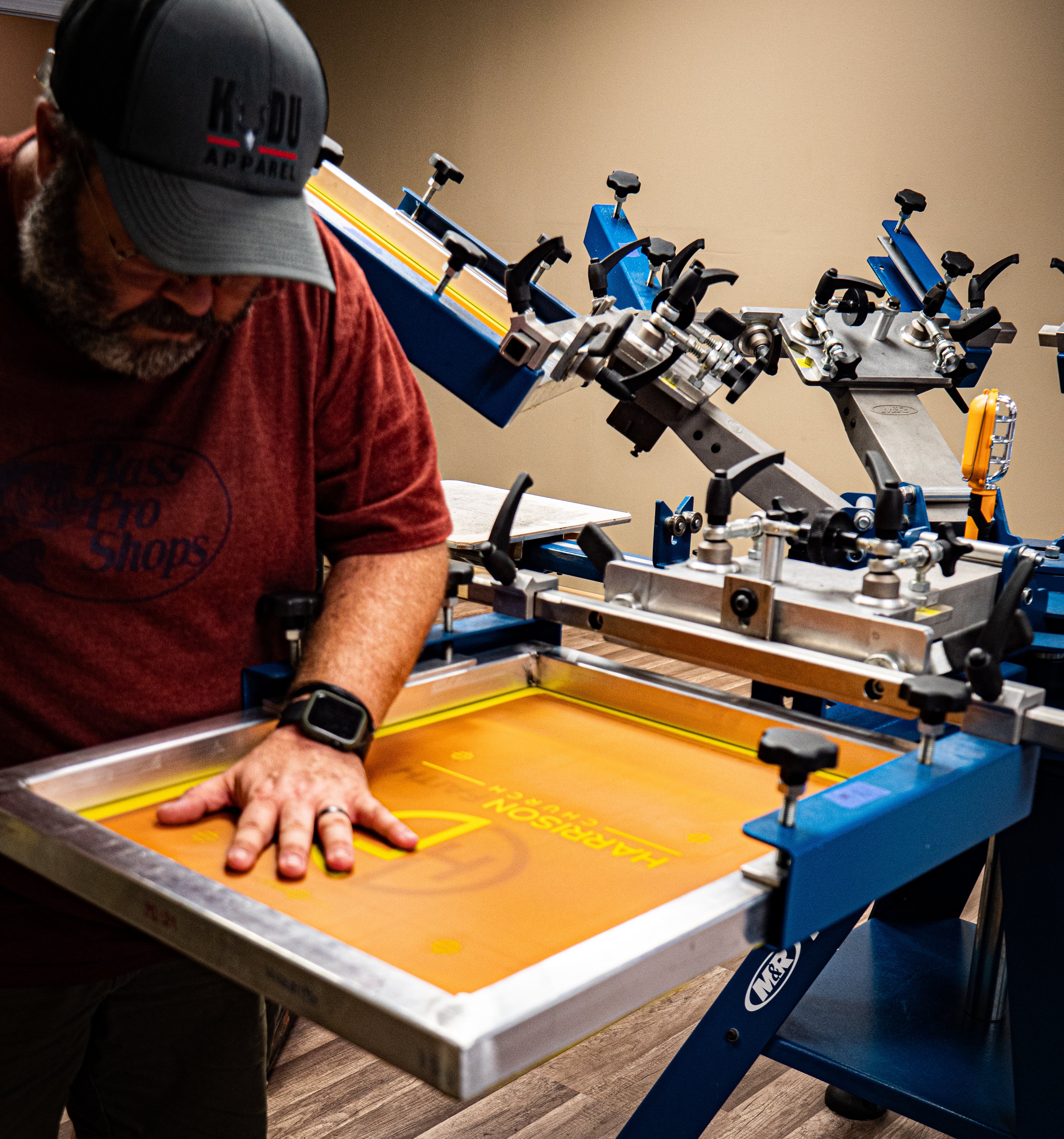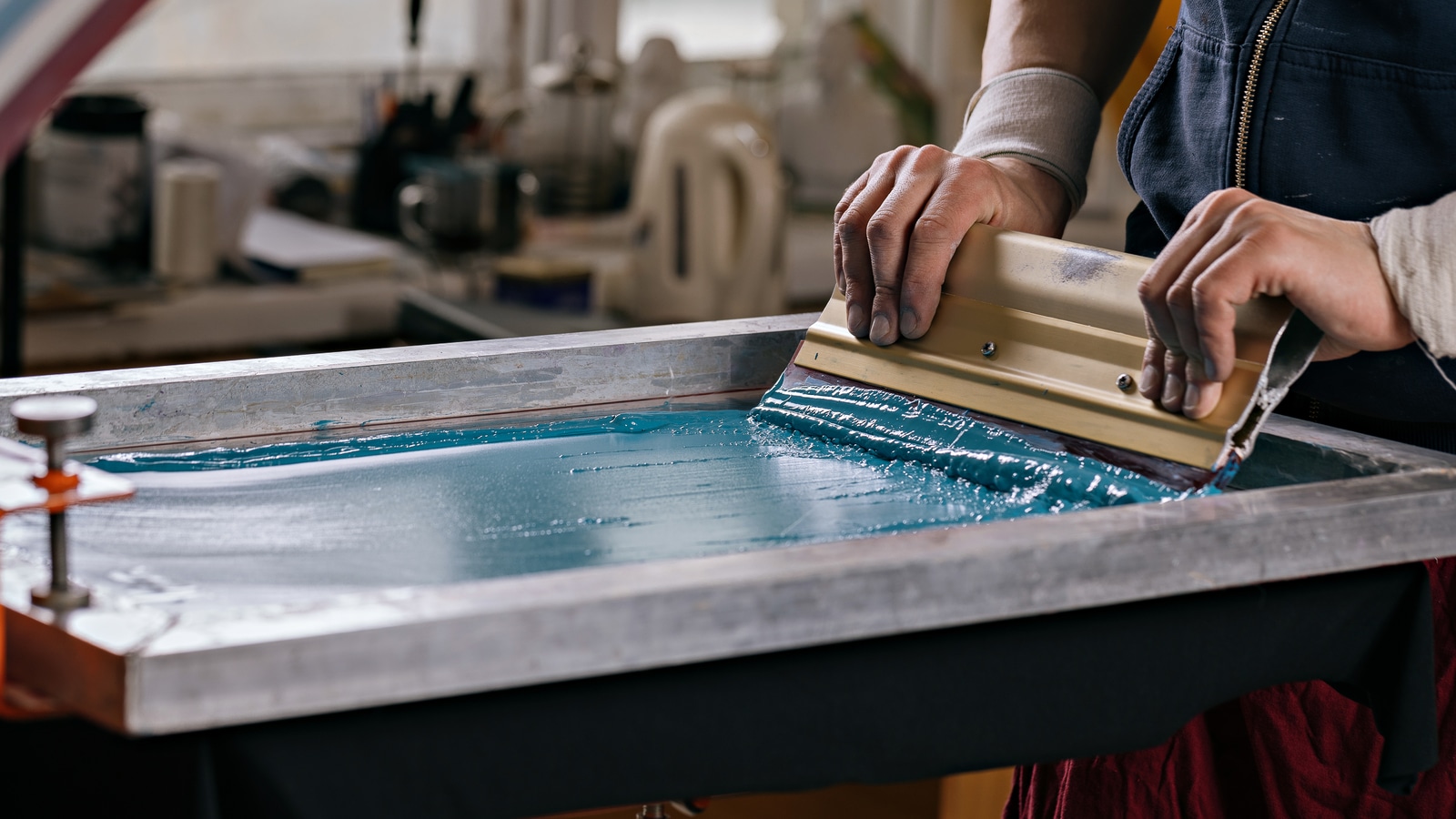Silk Screen Printing for Bold and Lasting Designs
Screen Printing Uncovered: Everything You Need to Understand About Tee Shirt and Garment Printing Techniques
If you've ever questioned exactly how those vivid styles end up on your favorite t-shirts, you're in the right place. Screen printing is a fascinating technique that integrates art with method, using countless possibilities for creativity. Understanding the fundamentals, from equipment to ink selections, can greatly impact your outcomes. All set to check out the crucial components that make display printing an art form? Let's reveal the information that can raise your jobs.
The Essentials of Screen Printing: Just How It Works
When you dive right into display printing, you'll uncover it's both an art and a scientific research. At its core, display printing includes producing a stencil, or screen, that permits ink to pass via only in particular areas.
Setting the display over the fabric, then make use of a squeegee to press ink through the display onto the garment. Each step is important, and mastering them will raise your display printing skills, changing easy garments right into special, expressive pieces.
Kinds of Display Printing Strategies
Once you grasp the basics of screen printing, it's time to explore the various techniques that can raise your layouts. One preferred approach is traditional screen printing, where ink is pressed via a stenciled display. This technique is great for vibrant, dynamic shades. Then there's water-based ink printing, which supplies a softer feeling and is environmentally friendly, yet it requires a different technique to treating.
One more option is plastisol printing, understood for its durability and dazzling colors, making it a favored for numerous brand names. Experiment with halftone printing to create gradient impacts and elaborate layouts.
Crucial Devices for Screen Printing
To attain stunning outcomes in screen printing, having the best devices is fundamental. You'll need a strong screen printing framework, which holds the mesh that moves your layout onto the garment. Next, spend in premium squeegees; these are important for applying ink uniformly across the display.
Selecting the Right Inks and Materials
When picking inks and products for display printing, you need to take into consideration the type of ink that works ideal for your task. Consider material compatibility to guarantee your styles look excellent and last lengthy. Additionally, discover environment-friendly ink options to make your printing process much more lasting.
Kinds of Display Inks
Selecting the right display ink is vital for achieving dynamic, sturdy prints that satisfy your project's needs. There are numerous kinds of screen inks to take a look at. Specialized inks, such as metal or glow-in-the-dark, can add distinct results to your layouts.

Fabric Compatibility Factors To Consider
Understanding material compatibility is essential for attaining high-grade screen prints, especially considering that different products react distinctly to numerous inks. When picking inks, consider the material kind-- cotton, polyester, or blends. For cotton, water-based inks work well, using softness and breathability. Polyester, on the various other hand, commonly calls for plastisol inks for better adhesion and lively shades. You may need to make use of a mix of both types if you're publishing on blends. Constantly check your inks on example fabric to ensure they stick effectively and keep shade honesty. In addition, remember that material weight and appearance can affect the final result, so selecting the best ink and product combination is vital for your project's success.
Eco-Friendly Ink Options
Environmentally friendly inks are coming to be a prominent option for display printers that desire to reduce their environmental influence while preserving quality. When choosing inks, take into consideration water-based inks, which are much less unsafe and much easier to cleanse up compared to conventional solvents.
In addition, look for inks made from renewable sources, such as soy or vegetable-based alternatives. By selecting the right inks and products, you'll not just develop magnificent layouts yet additionally add to a much more sustainable printing procedure. Make the button, and your prints will reflect your dedication to the atmosphere!
Preparing Your Layout for Screen Printing

File Layout Needs
To assure your design looks sharp and vibrant on textile, you'll require to pay very close attention to file style demands for screen printing. Beginning with vector data like AI or EPS, as they can be scaled without shedding quality. If you make use of raster pictures, opt for high-resolution documents, such as TIFF or PNG, ideally at 300 DPI. Prevent using JPEGs, as they can lose clearness when resized. Also, ensure your style has a clear background to prevent undesirable white edges on your prints. Maintain color settings in mind; CMYK is basic for display printing, so transform your RGB designs as necessary - screen printing kit. By following these standards, you'll set your art work up for a successful print.
Shade Splitting Up Techniques
Color splitting up is a vital step in preparing your style for display printing, and grasping it can significantly enhance your print top quality. You'll need to damage your design into private shades, as each color needs a separate screen throughout printing. Begin by determining all the shades in your style and develop layers for each one. You can utilize software program like Adobe Photoshop or Illustrator to isolate and different colors properly. Be certain to conserve each layer as a different documents, generally in a format like TIFF or PSD. This precision not only ensures precise color representation but also enhances the printing procedure. By paying interest to color splitting up, you'll accomplish specialist and vibrant cause your screen-printed garments.
Resolution and Size
Accomplishing the best lead to screen printing starts with ensuring your layout has the appropriate resolution and size. Ideally, your artwork needs to go to least 300 DPI (dots per inch) for sharp, clear prints. Your final product could look pixelated and less than professional. if you use reduced resolution.
When it involves size, consider the measurements of your print area. Layout your artwork to match the last print dimension, preferably developing it in the real measurements you'll be printing. This means, you'll avoid any unanticipated scaling problems.
Constantly check your layout in both vector and raster formats. Vector graphics can be scaled without losing top quality, making them optimal for screen printing. Preparing appropriately will ensure your style looks impressive on every garment!
Step-by-Step Screen Printing Process
Display printing is a vibrant procedure that permits you to develop vivid styles on numerous surface areas. To obtain begun, you'll need a screen, emulsion, and your selected ink.
After washing out the unexposed solution, your display prepares. Set it up on your printing surface and align your garment under it. Pour ink onto the screen and utilize a squeegee to push the ink with the stencil onto the material. Lift the display very carefully and let the print completely dry. Heal the ink using warmth to ensure resilience. That's it! You've successfully screen published your design.
Tips for Successful Screen Printing Projects
While you're diving into your display printing tasks, keep in mind that preparation is essential to success. Start by gathering all your products-- inks, displays, garments, and squeegees. A clean office assists stop undesirable errors, so clean before you begin.
Following, validate your artwork is high-resolution and correctly sized for your garment. Evaluate your screen for proper direct exposure and tidy it completely to stay clear of smudges. When mixing your inks, adhere to the producer's guidelines to accomplish the right uniformity.
Throughout printing, use also pressure with your squeegee for constant outcomes. Don't hurry; take your time to verify each print fulfills your requirements. After printing, allow your garments dry completely prior to managing or packaging them.
Finally, always maintain a sample of your benefit future reference. By doing this, you can evaluate your development and boost your strategies over time. Delighted printing!
Regularly Asked Questions
The length of time Does It Take to Establish up a Screen Printing Work?
Setting up a screen printing job usually takes about half an hour to an hour. You'll prepare the displays, mix inks, and adjust journalism. The time differs based upon intricacy and experience, so remain organized!
Can I Publish on Various Fabric Keys In Making Use Of the Very Same Method?
Yes, you can print on different material types utilizing the very same strategy, yet you'll require to readjust your settings and inks. Some fabrics soak up ink in a different way, so exploring guarantees the ideal results for every product.
What Prevail Errors to Avoid in Screen Printing?
When screen printing, stay clear of typical blunders like using the incorrect ink, neglecting appropriate exposure times, or missing pre-press checks. Constantly test your arrangement and maintain clean displays to assure top quality outcomes each time.
Exactly How Can I Correctly Tidy and Keep My Display Printing Equipment?
To correctly tidy garment printing and preserve your display printing devices, you must frequently wash displays with suitable solvents, inspect mops for wear, and guarantee all devices are stored dust-free and dry. Consistency enhances and prevents costly repair services efficiency.
Is Display Printing Ecologically Friendly Contrasted to Other Techniques?
Display printing can be a lot more eco-friendly than various other methods, particularly if you use eco-conscious materials and water-based inks. By choosing lasting materials and techniques, you lower waste and lessen your impact on the world.
Screen Printing Uncovered: Every Little Thing You Need to Know Concerning Tee and Garment Printing Techniques
At its core, display printing includes producing a pattern, or screen, that allows ink to pass through just in specific areas. Setting the display over the fabric, then make use of a squeegee to push ink through the screen onto the garment. One preferred technique is conventional screen printing, where ink is pushed with a stenciled screen.When selecting inks and materials for display printing, you require to take right into account the kind of ink that functions ideal for your job.